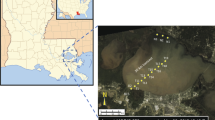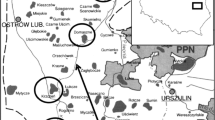Abstract
This paper explores mitigation scenarios for toxic cyanobacteria blooms in Lake Kasumigaura is located about 60–90 km northeast of Tokyo, in the southeast of Ibaraki Prefecture, Japan. Dominant species of cyanobacteria (Microcystis aeruginosa, Microcystis viridis and Microcystis ichthyoblabe) produce highly potent toxins as (Microcystin-(Leucine + Arginine, MC-LR), Microcystin-(Arginine + Arginine, MC-RR) and Microcystin-(Tyrosine + Arginine, MC-YR) in the Lake. Toxin production is generally the result of two major factors-natural processes and human interferences. Both factors have an extreme influence on the generation of cyanobacteria toxins within lake ecosystems. To address these factors, we propose two concepts for mitigation. The first concept is intended for examining the natural process of toxin production behavior within the lake and the second concept is used for evaluating inflow of wastes and nutrients from human activities that form toxins. Our research aims to combine both strategies to mitigate impacts of toxins, by examining trends of cyanobacteria nutrient sources, buoyancy regulations that influence bloom formation, and the environmental conditions that spur blooms. This study proposes a simple IMPACT (Integrating Mitigation Policies for Aquatic Cyanobacteria Toxin) model for diminution strategies of harmful algal blooms and their toxins. A mixed-methods approach is employed, nested within the Environmental Systems Analysis (ESA) tools e.g. scenario analysis and stakeholder analysis. The quality of the lake is assessed through a combination of observation and field study analysis. The findings suggest that successful mitigation of cyanobacteria toxins is highly dependent on multi-functional, multi-stakeholder involvement, and relevant intergovernmental policy. Without integrating approaches among different stakeholders, diverse socioeconomic activists, local-national policymakers and effective policy measures, prevention of cyanobacteria toxin production within lakes becomes extremely complex and difficult. The proposed IMPACT model could be a decision framework for identifying suitable policies that mitigate cyanobacteria impacts.







Similar content being viewed by others
References
Aiba S, Okada M, Sudo R, Ogawa T, Sekine T (1983) Simulation of water bloom in a eutrophic lake-I: photosynthetic characteristics of Microcystis aruginos. Water Res 17(8):869–876
Alcamo J, Kreileman GJJ, Leemans R (1998) (eds) Global Scenarios of the 21st Century. Elsevier Science, Oxford, pp 296–305
Boesch DF, Anderson DM, Horner RA, Shumway SE, Tester PA, Whitledge TE (1997) Harmful Algal Blooms in Coastal Waters: Options for Prevention, Control, and Mitigation, NOAA Coastal Ocean Program Decision Analysis Series No. 10. NOAA Coastal Ocean Office, Silver Spring, 46pp
Bonnet MP, Poulin M (2002) Numerical Modeling of the planktonic succession in a nutrient-rich reservoirs: environmental and physiological factors leading to microcystis aeruginosa dominance. Ecol Model 156:93–112
Carmichael WW, Mahmood NA (1990) Natural toxins from cyanobacteria (blue green algae). In: Hall S, Strichartz G (eds) Marine Toxins: Origin, Structure and Molecular Pharmacology, American Chemical society, Washington, DC.ACS Symposium Series 418 (6):87–106
Carpenter SR, Fisher SG, Grimm NB, Kitchell JF (1992) Global change and freshwater ecosystems. Annu Rev Ecol Syst 23:119–139
Falconer IR, Humpage AR (2006) Cyanobacterial (blue-green algal) toxins in water supplies: Cylindrospermopsis. Environ Toxicol 21(4 Sp. Iss. SI):299–304
Falk JM, Darby FL, Kempton W (2000) Understanding Mid-Atlantic Residents Concerns, Attitudes, and Perceptions about Harmful Algal Blooms: Pfiesteria piscicida. DEL- SG-05-00. University of Delaware Sea Grant College Program, 401 Academy Street Newark, DE 19716, USA. 44 pages +appendices
Ferguson AJD (1997) The role of modeling in the control of toxic blue green algae. In: Howard A (ed) Algal Modelling: Processes and management, Hydrobiologia 349:1–4
Findeisen A, Quade ES (1997) The methodology of systems analysis: an introduction and overview. In: Quade ES, Miser HJ (1997) Handbook of systems analysis: overview of uses, procedures, application and practice, Chichester, Vol. 1, Chapter 4: 117–149
Gardner RC, Connolly KD (2007) The Ramsar Convention on Wetlands: Assessment of International Designations within the United States, Environmental Law Reviewer ELR 10089, USA 2 (37): 1–25
Gerten D, Adrian R (2000) Climate driven changes in spring plankton dynamics and the sensitivity of shallow polymictic lakes to the North Atlantic Oscillation. Limnol Oceanogr 45(5):1058–1066
Goda T, Matsuoka Y (1986) Synthesis and analysis of compressive Lake model with the evaluation of diversity of ecosystems. Ecol Model 31:32–11
Gromov V, Vepritsky AA, Mamkaeva KA, Voloshko LN (1996) A survey of cyanobacterial blooms in Lake Ladoga and adjacent water bodies. Hydrobiologia 322:129–136
Grover JP, Crane KW, Baker JW, Brooks BW, Roelke DL (2011) Spatial variation of harmful algae and their toxins in flowing water habitats: a theoretical exploration. J Plankton Res 33(2):211–227
Guven B, Howard A (2006) Modelling the growth and movement of cyanobacteria in river systems. Sci Total Environ 368:898–908
Hage M, Leroy P (2008) Stakeholder Participation Guidance for the Netherlands Environmental Assessment Agency Practice Guide, Netherlands Environmental Assessment Agency (NEAA) and Radbound University Nijmegen, MNP Publication: 6–40
Hamilton PB, Ley LM, Dean S, Pick FR (2005) The occurrence of the cyanobacterium Cylindrospermopsis raciborskii in Constance Lake: an exotic cyanoprokaryote new to Canada. Phycologia 44(1):17–25
Harada KI, Mayumi T, Shimada T, Fujii K, Kondo F, Park H, Watanabe MF (2001) Co-production of microcystins and aeruginopeptins by natural cyanobacterial bloom. Environ Toxicol 16(4):298–305
Homma T, Komatsu N, Negishi M, Katagami Y, Nakmura K, Park HD (2007) Influence of Dissolved Inorganic Nitrogen and Phosphorus Concentration on the Horizontal and Temporal Changes of Microcsytsis Population in Lake Kitaura. Proceedings of Taal 2007: The 12th World Lake Conference: 1423–29
Hunter PR (1992) Cyanobacteria and human health. J Med Microbiol 36:301–302
Inamori Y, WU XL, Kimochi Y, Onuma K, Shinozaki K, Yaguchi K, Sudo R (1999) Technology Development for Renovating the Polluted Lake Environment Using Ecological Engineering Approaches and Overall Assessment of the Developed Systems, 8th International Conference on the Conservation and Management of Lakes hold in Shiga Prefecture in Japan at May 1999
Indabawa II (2009) Detection of Variants of Microcystin produced by Microcystis Aeruginosa in Some Burrow Pits of Kano, Nigeria. Bajopas 2(1):189–197
IPCC (2001) Climate Change 2001: The Scientific Basis. Third Assessment Report of the Intergovernmental Panel on Climate Change. Cambridge Univ. Press, Cambridge
Ishii Y, Harigae S, Tanimoto S, Tohru Y, Yoshida T, Taki K et al (2010) Spatial variation of phosphorus fractions in bottom sediments and the potential contributions to eutrophication in shallow lakes. Limnol 11:5–16
Kennedy VS, Twilley RR, Kleypas JA, Cowan JH, Hare AR (2002) Coastal and marine ecosystems & Global climate change: Potential Effects on U.S. Resources. Publish by PEW center Global Climate Change
Komarek J, Komarkova J (2002) Review of the European Microcystis morphospecies (Cyanoprokaryotes) from nature. Czech Psychology 2:1–24
Moore SK, Trainer VL, Mantua NJ, Parker MS, Laws EA, Backer LC, Fleming LE (2008) Impacts of climate variability and future climate change on harmful algal blooms and human health. Environ Heal 7(Suppl 2):S4
Nagai T, Imai A, Matsushige K, Fukushima T (2007) Growth characteristics and growth modelling of Microcystis aeruginnosa and Palnktothrix agadhil under iron limitation. Limnology 8:261–270. doi:10.1007/s10201-007-0217-1
Numazawa A, Takishita T, Ito H, Okawa K., Mayama Y, Yoshida K (2009) Global warming threatens Lake Kasumigaura, a highly-developed, desalinated former maritime lagoon in Japan. Proceedings of the 13th World Lake Conference. S2–7
Okello W, Kurmayer R (2011) Seasonal development of cyanobacteria and microcystin production in Ugandan freshwater lakes. Lakes & Reservoirs: Research and Management 16:123–135
Otsuka S, Suda A, Li R, Matsumoto S, Watanabe MM (2000) Morphological variability of colonies of Microcystis morphospecies in culture. J Gen Appl Microbiol 46:39–50
Ozawa K, Yokohama A, Ishikawa K, Kumagai M, Watanabe MF, Park HD (2003) Accumulation and depuration of microcystin produced by the cyanobacteria microcystis in a freshwater snail. Limnology 4:131–138
Paerl HW, Huisman J (2001) Climate change: a catalyst for global expansion of harmful cyanobacterial blooms. Environ Microbiol Rep 1(1):27–37
Park HD, Watanabe MF, Harada KI, Suzuki M, Hayashi H, Okino T (1993) Seasonal variations of Microcystis species and toxic heptapeptide microcystins in Lake Suwa. Environ Toxicol Water Qual 8(4):425–435
Paul VJ, Thacker R, Banks K, Golubic S (2005) Benthic cyanobacteria bloom impacts on the reefs of South Florida (Broward County, USA). Coral Reefs 24:693–697
PreBel K, Stuken A, Wiedner C, Chorus I, Fastner J (2005) First report on Cylindrospermopsin producing Aphanizomenon flos-aquae (cyanobacteria) isolated from two German lakes. Toxicon 47:156–162
Reutter JM (1989) Lake Erie: Phosphorus and eutrophication. Fact Sheet 015. Ohio Sea Grant College Program, Columbus.
Reynolds CS, Irish AE (1997) Modeling Phytoplankton dynamics in lakes and reservoirs: the problem of in-situ growth rates. Hydrobiologia 349:5–17
Saker ML, Kramer D, Vasconcelos VM (2007) Molecular techniques for the early warning of toxic cyanobacteria blooms in freshwater lakes and rivers. Appl Microbiol Biotechnol 75:449–441
Song L, Sano T, Li R, Watanabe MM, Liu Y, Kaya K (1998) Microcystin production of microcytis viridis (cyanobacteria) under different culture conditions. Physiol Res 46:19–23
Stewart I, Seawright AA, Schluter PJ, Shaw GR (2006) Primary irritant and delayed-contact hypersensitivity reactions to the freshwater cyanobacterium Cylindrospermopsis raciborskii and its associated toxin cylindrospermopsim. BMC Dermatology 6:5–11
Takamura N, Watanabe M (1987) Seasonal changes in the biomass of four species of Microcystis in Lake Kasumigaura. Jpn J Limnol 48(1):139–144
Takashima Y, Watanabe N, Yanai T, Nakmura T (2005) The Status of Koi Herpersvirus Disease Outbreaks in Lake kasumigaura and Kitaura. Bull Fish Resour Agency Suppl 2:65–71
Tanaka T, Rassoulzadegan F, Thingstad TF (2004) Orthophosphate uptake by heterotrophic bacteria, cyanobacteria, and autotrophic nanoflagellates in Villefranche Bay, northwestern Mediterranean: Vertical, seasonal, and short-term variations of the competitive relationship for phosphorus. Limnol Oceanogr 49(4):1063–1072
Visser PM, Passarge J, Mur LR (1997) Modelling vertical migration of the cyanobacterium Microcystis. Hydrobiologia 349:99–109
Wallace BB, Hamilton DP (2000) Simulation of Water bloom formation in the cyanobacterium Microcystis aeruginosz. J Plankton Res 22(6):1127–1138
Wilson AE, Sarnelle O, Neilan BA, Salmon TP, Gehringer MM, Hay ME (2005) Genetic variation of the bloom-forming cyanobacterium Microcystis aeruginosa within and among Lakes: implications for harmful algal blooms. Appl Environ Microbiol 71(10):6133–6126
Wu G, Xu Z (2011) Prediction of algal blooming using EFDC model: case study in the Daoxiang Lake. Ecol Model 222(6):1245–1252
Yokohama A, Park HD (2003) Depuration Kinetics and Persistence of the Cynaobacterial Toxin Microcystin-LR in the Freshwater Bivalve Unio douglasiae. Published online in Wiley Inter Science. Wiley Periodicals, Inc. doi:10.1002/tox.10102
Acknowledgements
The MEXT (The Ministry of Education, Culture, Sports, Science and Technology, Japan) provided funding to the main author of this paper through the Monbukagakushō (MEXT) scholarship. The authors show the debt gratitude to the Ibaraki Kasumigaura Research Center, National Environmental Research Center and Department of Environmental Sciences, Shinshu University, Japan. Feedback from anonymous reviewers helped to improve the quality of this research.
Author information
Authors and Affiliations
Corresponding author
Rights and permissions
About this article
Cite this article
Islam, M.N., Kitazawa, D., Hamill, T. et al. Modeling mitigation strategies for toxic cyanobacteria blooms in shallow and eutrophic Lake Kasumigaura, Japan. Mitig Adapt Strateg Glob Change 18, 449–470 (2013). https://doi.org/10.1007/s11027-012-9369-3
Received:
Accepted:
Published:
Issue Date:
DOI: https://doi.org/10.1007/s11027-012-9369-3




